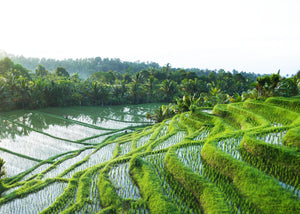Rice is one of the oldest and most widespread cereals in the world, representing a fundamental pillar for the nutrition of billions of people. Its origins date back to about 10,000 years ago , on the slopes of the Himalayas, where it began to be cultivated before spreading throughout the world. Over the centuries, rice has adapted to different climates and the needs of populations, becoming a key crop in many agricultural economies.
Origins and diffusion of rice

The rice plant, scientifically known as Oryza sativa , originated in the mountainous regions of Asia, probably between India, China and Thailand. From here, cultivation spread in two directions, giving rise to the two large families of rice:
- Indica → It has long, thin grains, grows in warm climates and represents about 90% of world production . It is the most widespread variety in Asia and tropical regions.
- Japonica → It has short, rounded grains, is grown in cooler climates and constitutes about 10% of world production . It is typical of temperate regions, such as Italy, Japan and Spain.
Today, rice is grown on approximately 165 million hectares worldwide, with 89% of production concentrated in Asia . In Europe, the cultivated area is much smaller, with approximately 650,000 hectares , of which almost half is in Italy.
Cultivation in Italy
Italy is the main rice producer in Europe, with about 46% of total production . The most suitable regions are Piedmont and Lombardy , which together represent the heart of Italian rice cultivation, followed by Emilia-Romagna, Veneto, Sardinia and other regions with more limited production.
Among the Italian provinces, the main cultivation areas are:
- Pavia → 35% of national production
- Vercelli → 32%
- New York → 14%
A peculiarity of Italian rice growing is the use of flooding of the fields , which helps protect the plant from weeds and temperature changes, ensuring a high-quality harvest.
The different varieties of rice and the European classification
In Europe, rice is classified according to the length and shape of the grain into four main categories:
- Round → Short grain, ideal for soups and desserts.
- Medium → Slightly more elongated grain, used for timbales and creamy dishes.
- Long A → Long and firm grain, perfect for risottos.
- Long B → Tapered grain, perfect for salads and side dishes.
In Italy, the Rice Authority updates the grid of the main varieties every year. For example, in the case of Carnaroli , only 15% of the Carnaroli sold in 2023 was actually authentic Carnaroli , while the majority was made up of similar varieties such as Caravaggio or Leonidas CL .
The transition to the rice mill: from harvesting to processing
After harvesting, the raw rice, called paddy , is taken to the rice mill to be processed through various stages:
- Hulling → Removal of the husk to obtain brown rice.
- Selection → Removal of impurities and defective beans with sieves and optical sorters.
- Bleaching → Transformation of brown rice into white rice by abrasion.
- Packaging → The rice is packaged without additives or preservatives, guaranteeing freshness and quality.
Even processing waste, such as husk and chaff, are now reused in the circular economy , for example for the production of insulating materials for sustainable construction.
Protected designations: DOP and IGP
In Italy, there are some denominations that guarantee the origin and quality of rice:
- Riso di Baraggia Biellese e Vercellese DOP → The only DOP for rice in Italy, grown in an area suited to its microclimate and traditional techniques.
- Riso Nano Vialone Veronese PGI → Grown mainly in Veneto, ideal for creamy risottos.
- Po Delta PGI Rice → Produced in the provinces of Rovigo and Ferrara, appreciated for its consistency.
Rice culture in Italy: the Piedmont rice route
In recent years, the promotion of Italian rice has also been supported by the initiative “Strada del Riso Piemontese” , which organizes courses for rice sommeliers . These courses allow for a deeper knowledge of rice, from selection to tasting, promoting the culture of a food that is too often underestimated.
Conclusion
From the Himalayas to the Italian rice fields, rice has crossed eras and continents, becoming a pillar of the world's food supply. Its history and evolution are the testimony of a product that combines tradition, innovation and sustainability .

